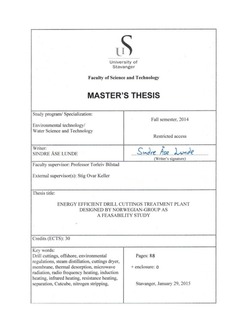| dc.contributor.author | Åse Lunde, Sindre | |
| dc.date.accessioned | 2015-09-17T07:54:45Z | |
| dc.date.available | 2015-09-17T07:54:45Z | |
| dc.date.issued | 2015-01-29 | |
| dc.identifier.uri | http://hdl.handle.net/11250/300379 | |
| dc.description | Masters Thesis in Environmental technology | nb_NO |
| dc.description.abstract | The cuttings produced by the oil and gas industry must be handled according to legislations. According to OSPAR, drill cuttings should contain less than 1 percent oil by weigh before discharged. There is several cuttings waste handling options. Treating the drill cuttings offshore is considered economically favorable. Some offshore treatment technologies are able to meet the legislation requirements.
Norwegian-Group AS provides a treatment plant concept intended for treating cuttings offshore. The treatment plant is based on three separation technologies. The first separation stage is a steam assisted cuttings dryer. The cuttings are then transported to the thermal separation. The thermal separation chamber is fitted with steam assistance combined with a heat source. Oil and water vapor from the cuttings dryer and thermal separation chamber is separated by a membrane. Clean steam is recirculated and reused.
This thesis evaluates the following topics. Potential steam supply systems for the cuttings dryer. Potential heat sources that can be combined with steam assistance in the thermal separation chamber. The feasibility of separating oil and water by membranes to reduce the energy consumption and cuttings handling cost. Potential advantages and limitations that the treatment plant may feature.
Increased the separation degree by utilizing steam in combination with the cuttings dryer is considered feasible.
The recommended heat source to be combined with steam in the thermal separation chamber is microwave radiation due to its energy efficiency and unique ability to desorb capillary bond water and oil.
On the other hand, the idea of using a membrane to reduce the energy consumption and cuttings handling costs is considered not attractive. As it cannot satisfy the aim of cost reduction.
The treatment plant may serve great advantages over the current cuttings handling options suited for offshore treatment. The potential advantages are related to treatment capacity, energy consumption and handling costs. Potential limitations are related to reaching the legislation of various cuttings characteristics. | nb_NO |
| dc.language.iso | eng | nb_NO |
| dc.publisher | University of Stavanger, Norway | nb_NO |
| dc.relation.ispartofseries | Masteroppgave/UIS-TN-IMN/2015; | |
| dc.subject | environmental regulations | nb_NO |
| dc.subject | cuttings dryer | nb_NO |
| dc.subject | thermal desorption | nb_NO |
| dc.subject | microwave heating | nb_NO |
| dc.subject | radio frequency heating | nb_NO |
| dc.subject | Cutcube | nb_NO |
| dc.subject | nitrogen stripping | nb_NO |
| dc.subject | resistance heating | nb_NO |
| dc.subject | TCC | nb_NO |
| dc.subject | drill cuttings | nb_NO |
| dc.subject | offshore teknologi | nb_NO |
| dc.subject | steam distillation | nb_NO |
| dc.title | Energy efficient drill cuttings treatment plant designed by Norwegian-Group AS A feasibility study | nb_NO |
| dc.type | Master thesis | nb_NO |
| dc.subject.nsi | VDP::Technology: 500::Environmental engineering: 610 | nb_NO |
